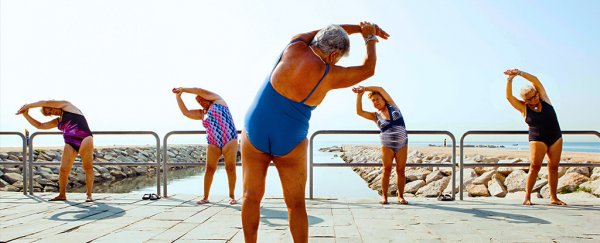In the modern western world, people tend to reduce their levels of physical activity as they get older. But with this inactivity comes a raft of adverse health effects, so why didn't evolution engineer us so that people could maintain a decent quality of life as they inevitably slow down?
In a newly published paper, researchers argue it is because we aren't meant to reduce our physical activity as we age at all. Enter the 'active grandparent hypothesis'.
Researchers have started to uncover beneficial processes that physical activity helps to promote, such as maintaining a lower blood pressure and reducing systemic inflammation. But it remains unclear why these mechanisms cease to operate to the same degree in the absence of physical activity, especially in older people who would rely on them to maintain their health and quality of life.
In the paper, David E. Liberman, Harvard evolutionary biologist and lead author of the study, adopts an evolutionary approach and draws on previous biomedical findings to explain why physical activity reduces illness and injury and extends longevity.
Evolutionary biologists have tended to argue that since only recent human generations have been able to put their feet up in their twilight years, evolution hasn't had a lot of time to adjust.
This might explain why we should take note of our ancestral habits and stay physically active as we age, but it doesn't tell us why our ancestors stayed active for so many of their 'retirement' years.
In laying out their evolutionary explanations, the authors break down some of the assumptions we have about ancient humans.
"Contrary to the widespread belief that human life-spans until recently were short, hunter-gatherers who survive infancy and childhood tend to live on average seven decades, approximately 20 years past the age at which they cease reproducing, and fossil evidence indicates that extended human lifespans were common by 40,000 years ago," the authors state in the paper.
Older individuals in social groups were not only evolutionarily selected for in humans because they could impart important knowledge and skills, but because they could also physically forage and contribute food supplies for their children and grandchildren.
"While the number of daily steps older Americans take decreases by about half between the ages of 40 and 70, daily walking distances among hunter-gatherers such as the Hadza decline only modestly with age," the authors note.
In debunking the myths that human beings in prehistory lived short lifespans and were relatively sedentary, the authors suggest that it may have been the allocation of resources to physical activity over other biological processes that could in fact have helped to prevent certain health issues from arising in the first place.
Under conditions where energy needs were typically met or exceeded, physical activity meant potentially harmful excess energy wasn't allocated to fat and reproductive tissues, where a large literature exists today demonstrating the negative health impacts of excessive fat storage.
An additional hypothesis put forward by the authors suggests that regular physical activity meant energy resources were allocated towards the repair and maintenance of tissue and cells that degrade with physical activity, and as a result come back stronger.
This includes the repairing of tears in muscle fibers, restoring cartilage damage, healing microfractures, as well as the releasing of exercise-related antioxidants and anti-inflammatories. Without physical activity, these responses are blunted.
Many studies over the years have put forth recommended suitable durations of exercise, with anywhere from around half an hour of moderate exercise a day to an hour of intense effort a week helping combat our sedentary lifestyles. Without it, we run a greater risk of developing a range of diseases, including cardiovascular disease, type 2 diabetes, Alzheimer's, and a number of cancers later in life.
Despite this wisdom, physical activity levels around the world are generally decreasing due to the introduction of technologies that have replaced human labor, such as motor and electric vehicles, agricultural equipment, and autonomous machinery, and have resulted in a growing number of health-related issues among the elderly.
"The key take-home point is that because we evolved to be active throughout our lives, our bodies need physical activity to age well. In the past, daily physical activity was necessary in order to survive, but today we have to choose to exercise, that is, do voluntary physical activity for the sake of health and fitness," says Liberman.
The study was published in Proceedings of the National Academy of Sciences.
